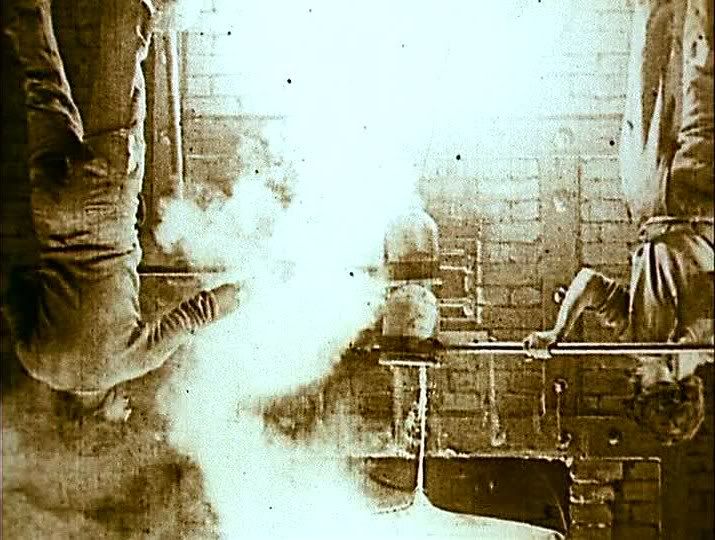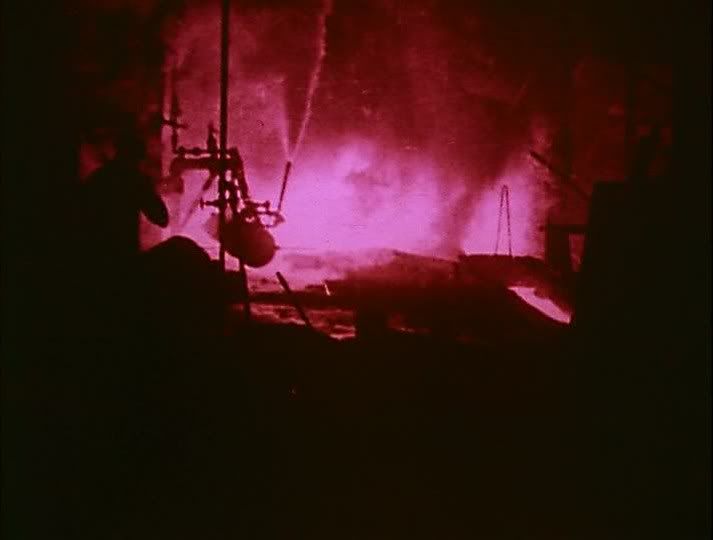
The collage films of the filmmaker-artist Joseph Cornell, assembled from found footage — mangled commercial and documentary films and occasional specially shot sequences provided by Cornell's filmmaker friends — are strange masterpieces of excavation and recontextualization. Cornell's films forage through the ephemera of film's accumulated history to pick out the moments of eerie, potent magic, augmenting and intensifying that magic through judicious editing and bursts of vibrant, artificial color. By Night With Torch and Spear was itself excavated from Cornell's massive private collection of film reels, discovered only after his death in the mid-70s and preserved by Anthology Film Archives. It is a stunning, mysterious film, one of Cornell's most beautiful and poetic works. It is only eight minutes long but contains layers upon layers of suggestions and emotions.
The film is assembled entirely from snippets of industrial documentaries and educational films, seemingly from the silent era. In the first long sequence — after a first shot in which a pointer traces along a white sheet marked with black dots, as though instructing the viewer to watch closely — an industrial process runs backwards and upside-down, its images sensuously drifting in reverse. A large pot of molten metal hangs upside-down, the boiling liquid within strangely pulsing downward, as though straining to pour out of its container, but somehow defying the laws of gravity to remain in place. Showers of sparks rain down like fiery comets, coming together into a yellow-hot center that then rushes back into the factory machinery like a fireball. Rivers of molten metal run upstream, up long conveyor belts, then crawl up the sides of a container, as though the industrial plant is full of an inexplicable liquid alien intelligence, an amorphous being moving of its own volition in defiance of the laws of physics. Cornell's editing and his manipulations of these images are deceptively simple, but the effect is anything but. These grainy, distorted images, discombobulated and flipped around, become almost magical, their poetic effect very far removed from the staid documentary context in which this footage originally resided.

This is the world made strange, an ultimate surrealist statement. Ordinary industrial machinery, seen through a bright pink filter, seems to glow with otherworldly energy, and the men tending to these strangely vibrant, effervescent industrial playgrounds are like sorcerers, conjuring inexplicable phenomena. Cornell explicitly compares his manipulated industrial age images to a shot of Native Americans silhouetted against a darkening night sky. Even that image isn't as simple as it seems, since the playful sprinting and obviously celebratory mood of these headdress-wearing figures suggests that perhaps they're not even genuine Native Americans, but children playing at a role, enacting games of cowboys and Indians like in a Hollywood movie. The movies certainly inform Cornell's vision to a great extent. In his most famous film, Rose Hobart, he clipped images of the titular silent era actress out of a melodramatic epic, out of context, honing in on the core of the cinema as a magic of faces, gestures, single dramatic images rather than stories.
In By Night With Torch and Spear, the cinema burbles up from the film's subconscious in the form of found and recontextualized intertitles, often manipulated in the same ways as the images themselves, turned around backward and upside-down, often flashed onto the screen in an almost subliminal fashion, too fast to read, certainly too fast to decode the mirrored text. In any event, the titles, even when decoded (thanks to a DVD pause function Cornell didn't plan for) are banal and generic, snippets of pseudo-scientific language or context-free bits of information about a machine, an insect, a group of people. Cornell treats these fragments of ordinary texts like incantations, a mysterious language to be deciphered, curious transmissions from deep within the cinematic subconscious, flashing like lightning across the surface of the film and then vanishing just as quickly back into the depths from which they emerged.
Later in the film, Cornell inserts ethnographic images of a man playing a non-Western instrument, and then the image that gives the film its name, a shadowy nighttime sequence of some men fishing by torchlight with a long wooden spear. This shot is preceded by the only easily intelligible intertitle in the film, and the most poetic as well: "by night with torch and spear." Cornell's images bring together Western industrial society with the amorphous Other, the exotic and the foreign. In essence, he exoticizes what would be, to Western audiences, the familiar, by making the processes of commerce and industry seem as haunting, and as haunted, as the exotic images of foreign lands and foreign people.

These images also exist on a continuum with Cornell's found footage of insects, seen up-close and made even more terrifying by the application of negative-image filters that make it seem as though the film is delving into a truly alien landscape, a barren gray moonscape populated by exoskeleton-clad monsters with fuzzy feelers and click-clacking mandibles. The film represents a journey from the working class factory to the Old West or the exotic Orient, stopping in Egypt for a desert scene replete with camels, then venturing deep into the unseen underworld of insects and then beyond, to a final image in which abstract dots pulsate like subatomic particles dancing to an unheard and unfathomable music.
Cornell sees the cinema as a transmitter of poetic distortions, as a massive bank of images to be combed for magical moments, moments that can be amplified and reworked into something epic and unfamiliar. His was a totally original and remarkable cinema, and this short is perhaps one of the finest examples of his unparalleled ability to dig out the strange essence at the core of the ordinary.

4 comments:
Wow. Never heard of this one, much less seen it. ALL of Cornell is gobsmacking. Rose Hobart most especially.
Back in the 80s on a visit to New York a screning of Rose Hobart was accompanied by its source film East of Borneo. Quite a revelation seeing them both together.
It's on DVD, on the fourth Treasures from American Film Archives, a great set dedicated to avant-garde film. This short was apparently discovered in the late 70s in a huge collection of Cornell's private archives at Anthology Film Archive. Great stuff, I may even prefer it to the wonderful Rose Hobart.
I have never heard of this particular work of Cornell's, but I must definitely now search it out. Excellent review of this film, as it has definitely piqued my interest. Thank you.
Thanks, Tracy. If you like Cornell, this is certainly one to seek out.
Post a Comment